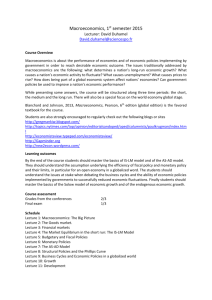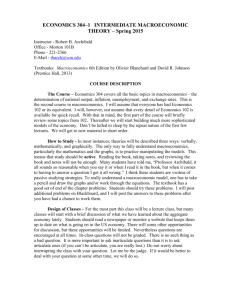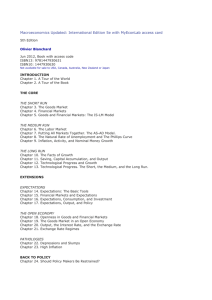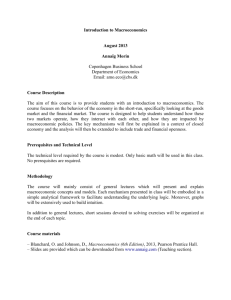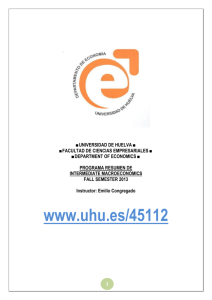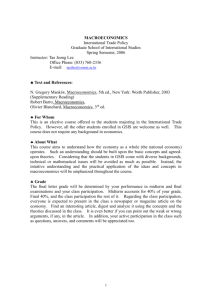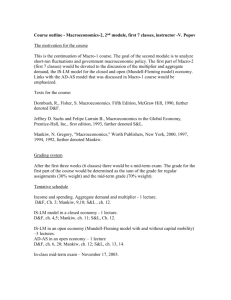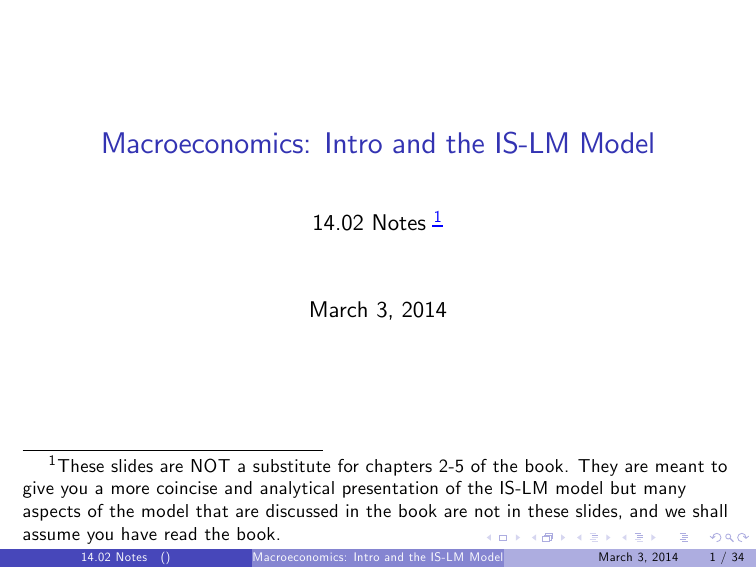
Macroeconomics: Intro and the IS-LM Model
14.02 Notes
1
March 3, 2014
1 These
slides are NOT a substitute for chapters 2-5 of the book. They are meant to
give you a more coincise and analytical presentation of the IS-LM model but many
aspects of the model that are discussed in the book are not in these slides, and we shall
assume you have read the book.
14.02 Notes
()
Macroeconomics: Intro and the IS-LM Model
March 3, 2014
1 / 34
Macroeconomics
To understand
how the …nancial crisis hit the real economy
how the government – through its monetary and …scal policies – was
able to alleviate the e¤ects of the …nancial shock on the economy
we need a model of the economy. Not of a single market, but of entire
economy. This is what macroeconomics is about: constructing models of
the aggregate economy and then using them to understand the e¤ects of
external shocks
policies
We start from the de…nition of the economy’s aggregate output
14.02 Notes
()
Macroeconomics: Intro and the IS-LM Model
March 3, 2014
2 / 34
GDP: The economy’s aggregate output. Three ways to
measure GDP: the example of an economy consisting of
only two …rms
Steel company
Car company
100$
Revenues
Expenses
wages
14.02 Notes
80$
20$
Pro…t
()
200$
Revenues
Expenses
wages
steel
Pro…t
70$
100$
30$
Macroeconomics: Intro and the IS-LM Model
March 3, 2014
3 / 34
1. GDP is the value of …nal goods (cars in the example)
produced in the economy in a given period. Value of cars
sold = 200$. See this merging the two companies
Steel company+Car company
200$
Revenues
Expenses
wages
50$
Pro…t
14.02 Notes
150$
()
Macroeconomics: Intro and the IS-LM Model
March 3, 2014
4 / 34
2. GDP is the sum of the value added in the economy in
a given period: 200$
Steel company
Car company
100$
Revenues
Expenses
wages
80$
20$
Pro…t
200$
Revenues
Expenses
wages
steel
Pro…t
70$
100$
30$
- steel company: value added = 100$
- car company: value added = 200$ - 100$ (steel bought) = 100$
14.02 Notes
()
Macroeconomics: Intro and the IS-LM Model
March 3, 2014
5 / 34
3. GDP is the sum of incomes (pro…ts plus salaries) in the
economy in a given period: 200$
Steel company
Car company
100$
Revenues
Expenses
wages
80$
20$
Pro…t
200$
Revenues
Expenses
wages
steel
Pro…t
70$
100$
30$
- incomes in the steel company: 80$ + 20$ = 100$
- incomes in the car company: 70$ + 30$ = 100$
14.02 Notes
()
Macroeconomics: Intro and the IS-LM Model
March 3, 2014
6 / 34
Nominal and real GDP
year
quantity of cars
price of cars
nominal GDP
real GDPin 2005$
2004
2005
2006
10
12
13
20,000$
24,000$
26,000$
200,000$
288,000$
338,000$
240,000$
288,000$
312,000$
14.02 Notes
()
Macroeconomics: Intro and the IS-LM Model
March 3, 2014
7 / 34
From nominal to real GDP and the Chain Index
You can compute the change in real GDP from year t to year t + 1 in two
alternative ways
Yt +1
Pt Qt +1
=
Yt
Pt Qt
or
Yt +1
Pt +1 Qt +1
=
Yt
Pt +1 Qt
the two ways of computing it are obviously identical
14.02 Notes
()
Macroeconomics: Intro and the IS-LM Model
March 3, 2014
8 / 34
From nominal to real GDP and the Chain Index
With two goods, Y1 and Y2 , the two ways of computing the change in real GDP
from year t to year t + 1 are no longer identical:
0
Yt +1
Yt
Yt +1
Yt
if you divide thorugh
=
00
=
Y t +1
Yt
0
P1,t Q1,t +1 + P2,t Q2,t +1
P1,t Q1,t + P2,t Q2,t
P1,t +1 Q1,t +1 + P2,t +1 Q2,t +1
P1,t +1 Q1,t + P2,t +1 Q2,t
by P1,t /P2,t and
Y t +1
Yt
00
by P1,+1 /P2,t +1 you
can verify that the two ways of computing the change in real GDP from year t to
year t + 1 are equal only if P1,t /P2,t = P1,+1 /P2,t +1 . Since the relative price
of goods changes over time, this condition will in general not be satis…ed. Thus
the two expressions will give you two di¤erent changes in real GDP.
14.02 Notes
()
Macroeconomics: Intro and the IS-LM Model
March 3, 2014
9 / 34
From nominal to real GDP and the Chain Index
The chain index addresses the problem by simply de…ning the change in GDP as
the weighted average of the two
g(01 /00 ) = .5
"
Yt +1
Yt
0
+
Yt +1
Yt
00
#
Finally it is customary to compute the change in real GDP using an index that is
(aribitrarily) set to be equal to 100 in a "base" year, say the year 2000:
chain index2000 = 100
chain index2001 = 100 g(01/00 )
14.02 Notes
()
Macroeconomics: Intro and the IS-LM Model
March 3, 2014
10 / 34
The Model of the Goods (and Services) Market (Model 1)
We proceed in steps, starting from the simplest model and then making
more complicated (realistic) by relaxing assumptions.
Model 1: The Goods market
1 market: the market for goods and services
1 variable to determine: the level of production, or output
(Y = GDP)
1 equilibrium condition to determine it:
Supply of Y = Demand for Y
14.02 Notes
()
Macroeconomics: Intro and the IS-LM Model
March 3, 2014
11 / 34
Supply of Y
The economy is closed: no goods are exported or imported
The price of Y is …xed
P (Y ) = P = 1
Therefore (for the time being)
$Y = Y
What does this assumption mean:
Output is determined by demand: at the …x price P = 1 …rms
produce any amount of Y needed to satisfy demand
14.02 Notes
()
Macroeconomics: Intro and the IS-LM Model
March 3, 2014
12 / 34
Demand for Y
Z
Consumption (C ) + Investment (I ) + Government Spending (G )
The 3 components of demand:
Consumption is a function of disposable income (income net of taxes)
C = c Y Disposable
= c 0 + c 1 (Y
T)
c1 is the marginal propensity to consume
Taxes, Government Spending and Investment are assumed to be
exogenous
T =T , I =I , G =G
14.02 Notes
()
Macroeconomics: Intro and the IS-LM Model
March 3, 2014
13 / 34
Consumption Function
Consumption is a function of disposable income (income net of taxes)
We shall assume a linear relationship
C = c Y Disposable
= c 0 + c 1 (Y
T )
where c 0 , c 1 (c0 > 0, 0 < c1 < 1) are positive parameters
14.02 Notes
()
Macroeconomics: Intro and the IS-LM Model
March 3, 2014
14 / 34
© Source unknown. All rights reserved. This content is excluded from our Creative
Commons license. For more information, see http://ocw.mit.edu/help/faq-fair-use/.
© United Nations. All rights reserved. This content is excluded from our Creative
Commons license. For more information, see http://ocw.mit.edu/help/faq-fair-use/.
Solving the Model
Variables
I
I
3 exogenous variables: T , I , G
1 endogenous variable: Y
F
once you know Y , C = c0 + c1 (Y
T ) determines C
Equations
I
1 equation: the market clearing condition, Y = Z
With 1 equation and 1 endogenous variable the model can be solved
What can move this economy away from an equlibrium?
I
I
policy, shifts in T or in G
shocks, shifts in …rms’or consumers’con…dence, i.e. shifts in I or c0
14.02 Notes
()
Macroeconomics: Intro and the IS-LM Model
March 3, 2014
15 / 34
Equilibrium in the Goods Market
The "equilibrium" level of Y is the level that clears the market, i.e.
makes supply equal to demand
Y = Z = C + I + G = c0 + c1 ( Y
T) + I + G
Thus the level of Y that clears the market is
Y = c 0 + c 1 (Y
14.02 Notes
()
T) + I + G
Macroeconomics: Intro and the IS-LM Model
March 3, 2014
16 / 34
Solving for the market equilibrium
C = c 0 + c 1 (Y
T ) C = c0 + c1 Y
c1 T
with
c1 < 1
solving for Y
Y =
c0 + I + G
1
1
c1
c1 T
c0 + I + G
c1 T
is Autonomus spending
Autonomus spending is spending that does not depend on Y
1
1
14.02 Notes
()
c1
> 1 is the Keynesian multiplier.
Macroeconomics: Intro and the IS-LM Model
March 3, 2014
17 / 34
Inventories
So far we have assumed
Output t =
∑ Final
Sales t
where t refers to some year.
What if not all output produced in year t is sold in year t ? Consider two
extreme cases:
∑ Final Salest = Outputt 1
or
Outputt =
Outputt
∑ Final
∑ Final
Salest +1
Salest = ∆Inventoriest
∆Inventories are called Inventory Investment. (Note Inventories are not
part of demand)
14.02 Notes
()
Macroeconomics: Intro and the IS-LM Model
March 3, 2014
18 / 34
Comparative Statics Exercises
Shifts in policy: G or T or both
Shifts in con…dence
I
I
consumers’con…dence can shift c0
…rms’con…dence can shift I
Remember
Y =
14.02 Notes
()
1
1
c1
c0 + I + G
Macroeconomics: Intro and the IS-LM Model
c1 T
March 3, 2014
19 / 34
© Pearson. All rights reserved. This content is excluded from our Creative Commons
license. For more information, see http://ocw.mit.edu/help/faq-fair-use/.
An example of the e¤ects of a policy shift: President
Obama’s 2009 Stimulus Program
Total package: US$ 800 bn (5,7% of 2008 GDP)
Composition of the package
I
I
2/3 ∆G > 0 : 533 US$ bn
1/3 ∆T < 0 : - 266 US$ bn
E¤ect of the package on Y for di¤erent values of c1
c1 = 0.3
multipliers
dY
1
dG = 1 c1
c1
dY
dT =
1 c1
14.02 Notes
1.4
0.4
()
c1 = 0.6
2.5
1.5
Macroeconomics: Intro and the IS-LM Model
March 3, 2014
20 / 34
E¤ects of President Obama’s 2009 Stimulus Program
under Model 1
c1 = 0.3: (1.4) (533) + (0.4) (266) = 852 US $bn (6.1% of GDP )
c1 = 0.6: (2.5) (533) + (1.5) (266) = 1.731 US $bn
(12.3% of GDP )
14.02 Notes
()
Macroeconomics: Intro and the IS-LM Model
March 3, 2014
21 / 34
Christina Romer’s Assumptions: E¤ects on Y of 1$ of
higher G or 1$ of lower T in period 0
(professor Christina Romer was President Obama’s …rst Chairperson of the
Council of Economic Advisers. Homework: Compute the multipliers Christina
used to get these numbers)
Quarter
1
2
3
4
5
6
G
1.05
1.24
1.35
1.44
1.51
1.53
14.02 Notes
()
T
0.00
0.49
0.58
0.66
0.75
0.84
Quarter
7
8
9
20
11
12
G
1.54
1.57
1.57
1.57
1.57
1.55
T
0.93
0.99
0.99
0.99
0.99
0.98
Macroeconomics: Intro and the IS-LM Model
March 3, 2014
22 / 34
A useful exercise: the Balanced-Budget Multiplier
What is the e¤ect on Y of an increase in G fully …nanced by a
corresponding increse in T
dG = dT
Y = c0 + c1 ( Y
dY
dT
= c1 (dY
= dG
dY (1
T) + I + G
dT ) + dG
c1 ) = dT (1
c1 )
dY = dT = dG
the multiplier is 1. You still get a positive e¤ect, but not bigger than 1:
the private sector (Consumption) does not move, thus there is no
"multiplier e¤ect".
14.02 Notes
()
Macroeconomics: Intro and the IS-LM Model
March 3, 2014
23 / 34
Investment equals Saving: An Alternative Way of Thinking
About Goods Market equilibrium
Start from Private Saving
S Pr
YD
C
Y
Now add the Saving by the Government T
Total Saving in the economy is
S Pr + S Pu = Y
T
C + T
T
C
G
G =Y
But from Goods Market Equilibrium we know that Y
Thus
S = S Pr + S Pu = I
14.02 Notes
()
Macroeconomics: Intro and the IS-LM Model
C
C
G
G = I.
March 3, 2014
24 / 34
The "Paradox" of Saving
Suppose consumers decide to save more at any level of Y . This means
that c0 falls. What happens to Saving ?
S PR =
c0 + ( 1
c1 ) Y
T
As c0 falls consumers tend to save more, but their income Y will also be
lower, which will reduce S. What is the net e¤ect? Remember that – when
there is equilibrium in the goods market – saving is equal to investment
I = S PR + T
G =S
then the net e¤ect is zero.
14.02 Notes
()
Macroeconomics: Intro and the IS-LM Model
March 3, 2014
25 / 34
Model 2 - The IS-LM Model
So far the only variable in the private sector that could respond to
shifts in policy (dT or dG ) or in "con…dence" (dI or dc0 ) is
consumption
What else could respond?
I
I
prices ? NOT in the Short Run. Prices are slow to respond. Our
assumption that prices are …xed is, as we shall see, not too bad. We
shall study what happens when prices respond in the Medium Run
…nancial markets? YES: the price of …nancial assets responds
instanteneously to news.
We thus extend the model adding a …nancial sector
14.02 Notes
()
Macroeconomics: Intro and the IS-LM Model
March 3, 2014
26 / 34
Introducing Financial Markets
Financial markets include many assets with decreasing degrees of
liquidity. From the most liquid (money) to the less liquid (equity)
I
cash, demand deposits, saving deposits, money market mutual funds,
government bonds, corporate bonds, equity
Start from the essentials. Assume there are only two …nancial assets
I
I
"money" (cash, demand deposits), that pays no interest
bonds, that pay an interest rate i per period
Think of the problem of how to allocate a given amount W between
bonds and cash: the higher the interest the larger the fraction of W
you will want to keep in bonds, and thus the more often you will go
to the bank to sell bonds and get cash.
14.02 Notes
()
Macroeconomics: Intro and the IS-LM Model
March 3, 2014
27 / 34
The demand for …nancial assets
Demand for "money" (M d ), the most liquid asset
M d = L (Y , i )
we shall assume L (Y , i ) = f1 Y f2 i with f1 , f2 (f1 , f2 > 0) two positive
parameters, so that
M d = f1 Y f2 i
Demand for Bonds (B d )
Bd = W
Md
where W is your wealth, which is divided between money and bonds.
Note: given W , if you know M d you do not need a second equation to
compute B
14.02 Notes
()
Macroeconomics: Intro and the IS-LM Model
March 3, 2014
28 / 34
"Stock" and "Flow" variables
So far we have introduced two types of variables in our model
Flow variables. Y , C : these are measured as ‡ows per unit time. For
instance C is consumption per period, e.g. per year
Stock variables. B, W , M: these are stocks at any moment in time
14.02 Notes
()
Macroeconomics: Intro and the IS-LM Model
March 3, 2014
29 / 34
Equilibrium in the …nancial market
As we said, one equilibrium condition is enough — because once we
know M, given W , we know B = W M
Equilibrium requires that the demand for money, M d , equals the
quantity of money that the central bank has put in the economy,
which, for the time being, we assume to be a …xed quantity M
Md = M
M d = L (Y , i ) = M
this equation determines the interest rate i for any given level of Y
and M
14.02 Notes
()
Macroeconomics: Intro and the IS-LM Model
March 3, 2014
30 / 34
Closing the model
How does i a¤ect the economy?
We focus on one channel only: Investment
Assumption: Investment depends on
I
I
i, the cost …rms face to borrow the funds needed to acquire new
machines, build a new plant, etc
Y , the level of demand
I = I (i, Y ) = d1 Y
d2 i
with d1 , d2 (d1 , d2 > 0) two positive parameters
14.02 Notes
()
Macroeconomics: Intro and the IS-LM Model
March 3, 2014
31 / 34
The structure of Model 2: the IS-LM Model
4 exogenous variables: T , I , G , M
2 endogenous variables: Y , i
Equations
I
2 equilibrium conditions
F
F
equilibrium in the goods market Y = Z
equilibrium in he …nancial market M d = M
With 2 equations and 2 endogenous variables, the model can be solved
What can move this economy away from an equilibrium?
I
I
policy, shifts in T , G , M
shocks, shifts in …rms’or consumers’con…dence, i.e. shifts in I or c0
14.02 Notes
()
Macroeconomics: Intro and the IS-LM Model
March 3, 2014
32 / 34
Solving the IS-LM Model
Two equations
equilibrium in the goods market
Y =Z
gives you the the IS Curve
Y = Y (i )
equilibirum in the …nancial market
Md = M
gives you the LM Curve
i = i (Y )
two equations and two unknows: the model is solved
14.02 Notes
()
Macroeconomics: Intro and the IS-LM Model
March 3, 2014
33 / 34
Multipliers in the IS-LM Model
dY
=
dT
(1
dY
=
dG
(1
dY
=
dM
(1
14.02 Notes
()
c1
c1
<0
d1 ) + d2 ff12
c1
1
>0
d1 ) + d2 ff21
c1
1
>0
d1 ) df22 + f1
Macroeconomics: Intro and the IS-LM Model
March 3, 2014
34 / 34
MIT OpenCourseWare
http://ocw.mit.edu
14.02 Principles of Macroeconomics
Spring 2014
For information about citing these materials or our Terms of Use, visit: http://ocw.mit.edu/terms.

